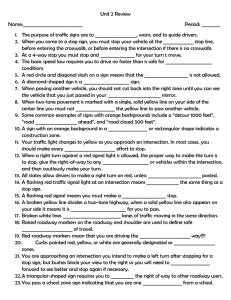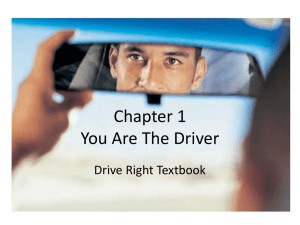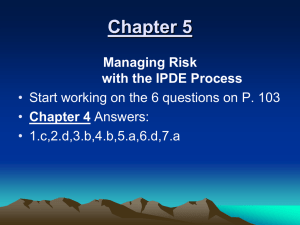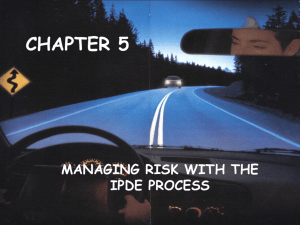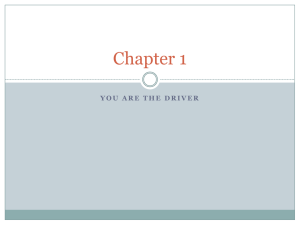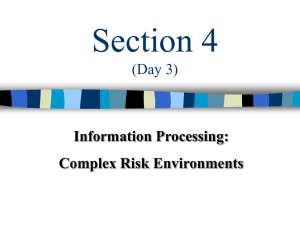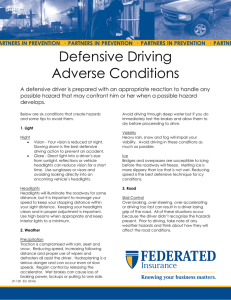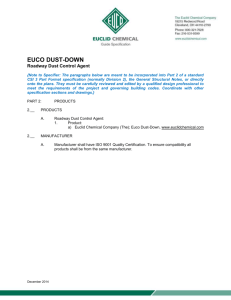DRIVER EDUCATION NOTES 1 CHAPTER 4: Making Safe Driving
advertisement
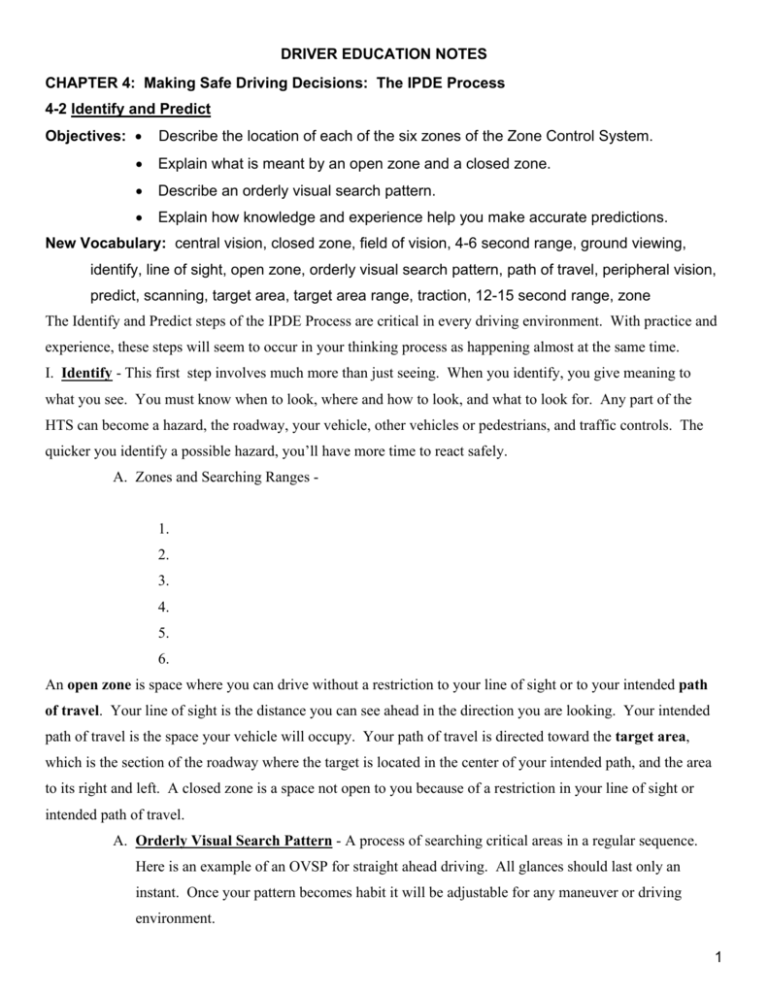
DRIVER EDUCATION NOTES CHAPTER 4: Making Safe Driving Decisions: The IPDE Process 4-2 Identify and Predict Objectives: Describe the location of each of the six zones of the Zone Control System. Explain what is meant by an open zone and a closed zone. Describe an orderly visual search pattern. Explain how knowledge and experience help you make accurate predictions. New Vocabulary: central vision, closed zone, field of vision, 4-6 second range, ground viewing, identify, line of sight, open zone, orderly visual search pattern, path of travel, peripheral vision, predict, scanning, target area, target area range, traction, 12-15 second range, zone The Identify and Predict steps of the IPDE Process are critical in every driving environment. With practice and experience, these steps will seem to occur in your thinking process as happening almost at the same time. I. Identify - This first step involves much more than just seeing. When you identify, you give meaning to what you see. You must know when to look, where and how to look, and what to look for. Any part of the HTS can become a hazard, the roadway, your vehicle, other vehicles or pedestrians, and traffic controls. The quicker you identify a possible hazard, you’ll have more time to react safely. A. Zones and Searching Ranges 1. 2. 3. 4. 5. 6. An open zone is space where you can drive without a restriction to your line of sight or to your intended path of travel. Your line of sight is the distance you can see ahead in the direction you are looking. Your intended path of travel is the space your vehicle will occupy. Your path of travel is directed toward the target area, which is the section of the roadway where the target is located in the center of your intended path, and the area to its right and left. A closed zone is a space not open to you because of a restriction in your line of sight or intended path of travel. A. Orderly Visual Search Pattern - A process of searching critical areas in a regular sequence. Here is an example of an OVSP for straight ahead driving. All glances should last only an instant. Once your pattern becomes habit it will be adjustable for any maneuver or driving environment. 1 DRIVER EDUCATION NOTES 1. 2. 3. 4. 5. 6. 7. B. Where and How to Look- Use the Smith System to help develop your visual search habits and protect yourself from the unsafe actions of others. 1. Aim High in Steering - 2. Keep Your Eyes Moving 3. Get the Big Picture 4. Make Sure Others See You - 5. Leave Yourself an Out - C. What to Look For - Use selective seeing in your identifying process. This means that you select and identify only those events and clues that pertain to your driving task. D. Search for Specific Clues - Use your visual search pattern to look for specific driving related clues. Don’t allow your eyes to stay to long on any one thing. Try to develop the art scanning – continual glancing through your visual search pattern. E. Look for Other Roadway Users - Look for different sizes and shapes of vehicles. Develop the habit of ground viewing in your search pattern, this means to quickly glance at the roadway in front of your vehicle. F. Look for Roadway Features and Conditions - Identify intersections, hills, and curves early. Be aware that the width of your lane might be reduced. (Examples) 1. 2 DRIVER EDUCATION NOTES 2. 3. 4. G. Look for Traffic Controls - Learn to look in different places for traffic controls. Identify early so you are able to make the correct responses. II. Predict - You interpret the information you have identified and see how this hazard might create a conflict. Predictions are based on 3 elements in the traffic scene. 1. The actions of other roadway users. 2. Your control of your vehicle. 3. The consequences of your actions. A. Actions of Other Roadway Users 1. 2. 3. 4. 5. B. Predicting Control of Your Vehicle and Possible Consequences- Speed is the most important factor in maintaining control of your vehicle. Always be prepared to adjust your speed for varying conditions and situations. At times, you will need to accelerate rather than brake in order to avoid a conflict. Determine all the alternatives of a situation and choose the best action. Review It 1. What is the location of each of the six zones of the Zone Control System? 2. What is an open zone and a closed zone? 3. Give an example of an orderly visual search pattern. 4. What effects do knowledge and experience have on your ability to make accurate predictions? 3
